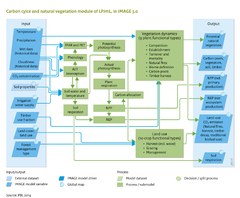Carbon cycle and natural vegetation: Difference between revisions
Jump to navigation
Jump to search
No edit summary |
No edit summary |
||
| Line 1: | Line 1: | ||
{{ComponentTemplate2 | {{ComponentTemplate2 | ||
|Status=On hold | |Status=On hold | ||
|IMAGEComponent=Atmospheric composition and climate; Agricultural systems; Forest management; Terrestrial biodiversity; Ecosystem goods and services; Land cover and use; | |IMAGEComponent=Atmospheric composition and climate; Agricultural systems; Forest management; Terrestrial biodiversity; Ecosystem goods and services; Land cover and use; | ||
|KeyReference=Sitch et al., 2003; | |KeyReference=Sitch et al., 2003; | ||
|Reference=Van Minnen et al., 2008; Houghton, 2010; Müller et al., 2007; Ballantyne et al., 2012; Van Minnen et al., 2009; Gerten et al., 2004; Bondeau et al., 2007; Klein Goldewijk et al., 1994; Van Minnen et al., 2000; | |Reference=Van Minnen et al., 2008; Houghton, 2010; Müller et al., 2007; Ballantyne et al., 2012; Van Minnen et al., 2009; Gerten et al., 2004; Bondeau et al., 2007; Klein Goldewijk et al., 1994; Van Minnen et al., 2000; | ||
|InputVar=Temperature; Precipitation; Wet days; Cloudiness; CO2 concentration; Crop and grass fractions; Timber use fraction; Timber harvest; | |InputVar=Temperature; Precipitation; Wet days; Cloudiness; CO2 concentration; Crop and grass fractions; Timber use fraction; Timber harvest; | ||
| Line 8: | Line 8: | ||
|Description=The terrestrial biosphere plays an important role in global and regional carbon (C) cycles and, thus, also in the climate system. Large amounts of carbon, between 2000 and 3000 PgC, are stored in the vegetation and soil components. Land conversions, such as deforestation, have considerably contributed to the increase in atmospheric carbon dioxide over the past centuries ([[Van Minnen et al., 2009]]; [[Houghton, 2010]]) and are projected to continue to do so in the future ([[Müller et al., 2007]]). The terrestrial biosphere currently absorbs about 30% of the emitted CO2 ([[Ballantyne et al., 2012]]), and a number of options exists to maintain or even enhance this sink; for example, through protecting existing forests and/or establishing new ones ([[Van Minnen et al., 2008]]). | |Description=The terrestrial biosphere plays an important role in global and regional carbon (C) cycles and, thus, also in the climate system. Large amounts of carbon, between 2000 and 3000 PgC, are stored in the vegetation and soil components. Land conversions, such as deforestation, have considerably contributed to the increase in atmospheric carbon dioxide over the past centuries ([[Van Minnen et al., 2009]]; [[Houghton, 2010]]) and are projected to continue to do so in the future ([[Müller et al., 2007]]). The terrestrial biosphere currently absorbs about 30% of the emitted CO2 ([[Ballantyne et al., 2012]]), and a number of options exists to maintain or even enhance this sink; for example, through protecting existing forests and/or establishing new ones ([[Van Minnen et al., 2008]]). | ||
=== | === Processes === | ||
The CO2 uptake by and release from the terrestrial biosphere is determined by a number of processes that are sensitive to environmental conditions, such as climate, atmospheric CO2 concentration and moisture. Hence, even if land cover and land use would remain unchanged, the strength of the current net sink may change, over time, in response to changes in those conditions. Basic processes include photosynthesis, plant and soil respiration, transpiration, carbon allocation and turnover, and disturbances, such as fires. Photosynthesis is the process where CO2 is taken up from the atmosphere and converted into organic carbon compounds. This conversion of CO2 is called gross primary production ([[HasAcronym::GPP]]). The sequestered carbon is partially needed for plant maintenance and growth (autotrophic respiration), while the remainder (net primary production [[HasAcronym::NPP]]) is incorporated in new tissues in various parts of plants, forming live biomass carbon pools. The ultimate fate of these plant parts (incl. leaf fall and mortality) cause the stored carbon to be transferred to various carbon pools, such as the soil and the atmosphere. From the soil pools, through processes of mineralisation, CO2 is also emitted back into the atmosphere. | The CO2 uptake by and release from the terrestrial biosphere is determined by a number of processes that are sensitive to environmental conditions, such as climate, atmospheric CO2 concentration and moisture. Hence, even if land cover and land use would remain unchanged, the strength of the current net sink may change, over time, in response to changes in those conditions. Basic processes include photosynthesis, plant and soil respiration, transpiration, carbon allocation and turnover, and disturbances, such as fires. Photosynthesis is the process where CO2 is taken up from the atmosphere and converted into organic carbon compounds. This conversion of CO2 is called gross primary production ([[HasAcronym::GPP]]). The sequestered carbon is partially needed for plant maintenance and growth (autotrophic respiration), while the remainder (net primary production [[HasAcronym::NPP]]) is incorporated in new tissues in various parts of plants, forming live biomass carbon pools. The ultimate fate of these plant parts (incl. leaf fall and mortality) cause the stored carbon to be transferred to various carbon pools, such as the soil and the atmosphere. From the soil pools, through processes of mineralisation, CO2 is also emitted back into the atmosphere. | ||
Revision as of 16:48, 6 January 2014
Parts of Carbon cycle and natural vegetation
| Component is implemented in: |
|
| Related IMAGE components |
| Models/Databases |
| Key publications |
| References |
Key policy issues
- What is the role of the terrestrial biosphere in the global carbon cycle, how will it change in time as a result of climate and land-use change?
- To what extent can the terrestrial biosphere contribute to reducing the accumulation of CO2 in the atmosphere and what are viable mechanisms?
- What opportunities exist to reduce land-use related carbon emissions (e.g. REDD) and even enhance the carbon uptake through the establishment of new forests.
- What are the contributions of land-use change, climate change and CO2 fertilization on the future carbon cycle and how can these be considered in climate policies?
Introduction
